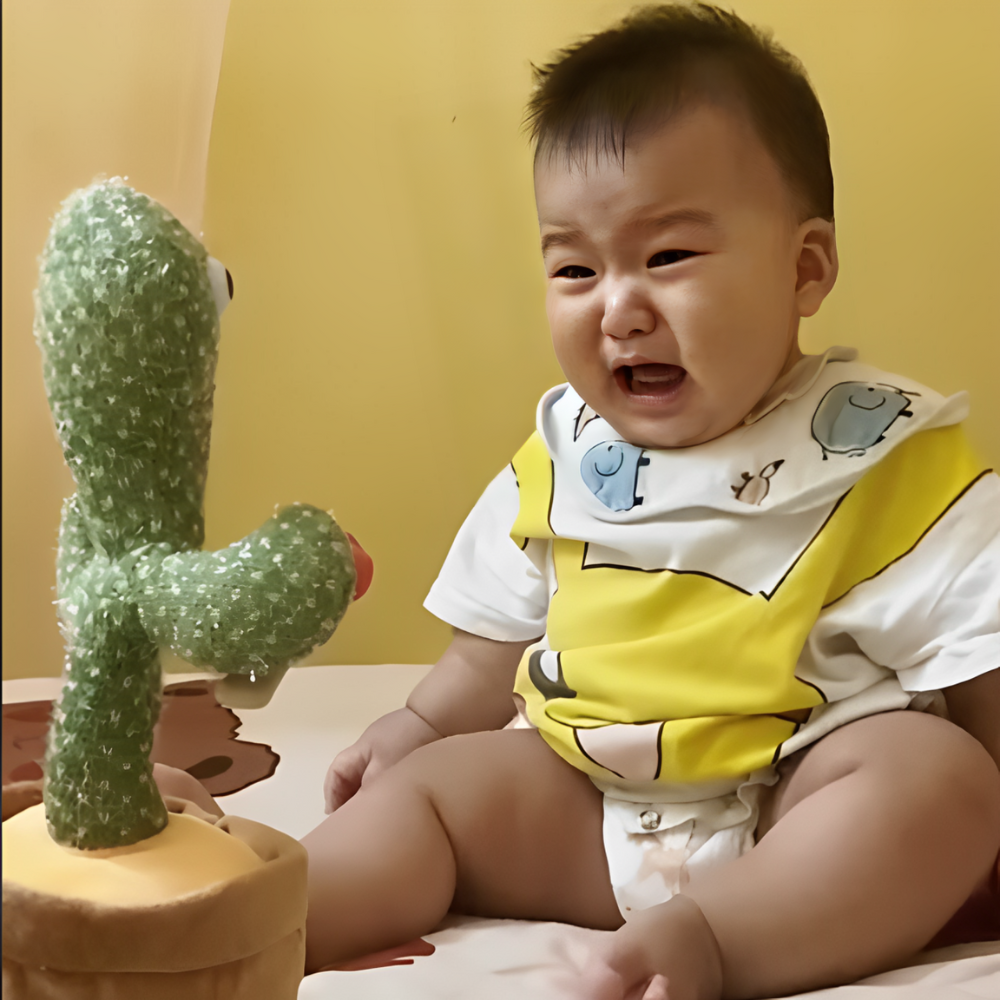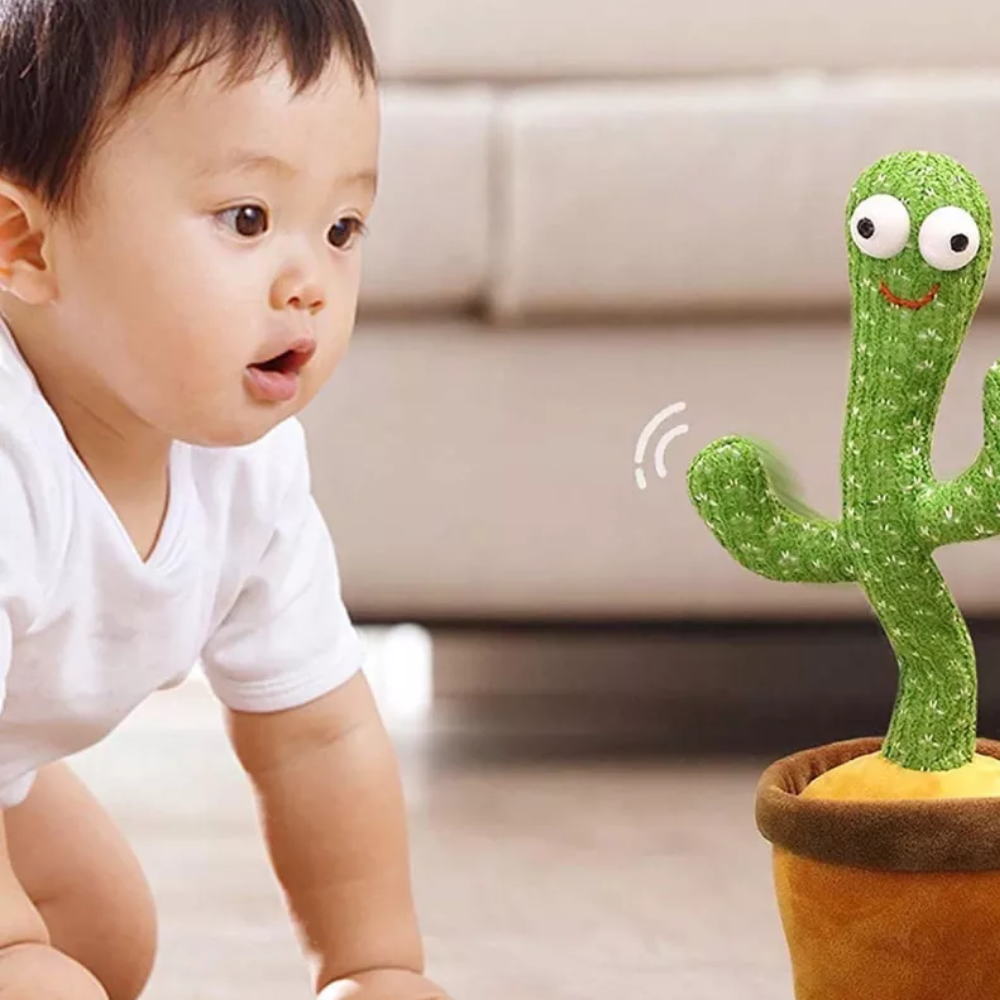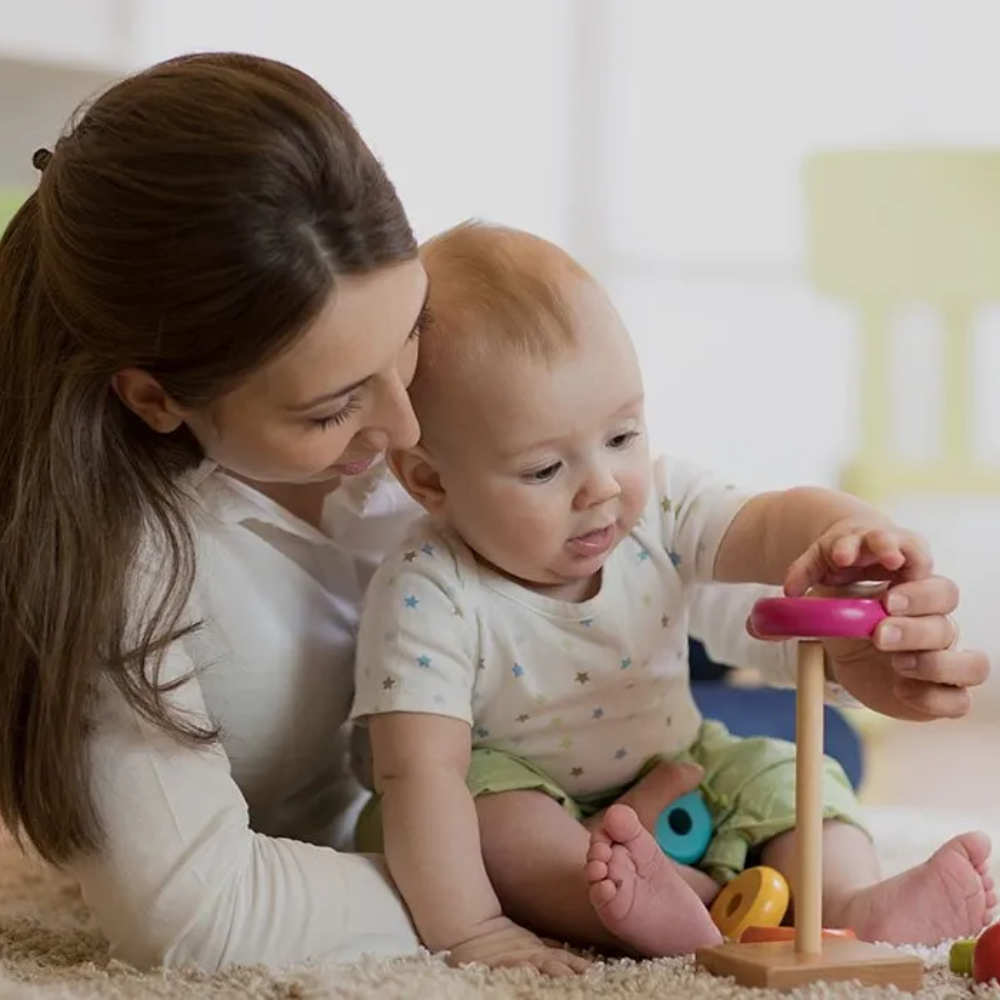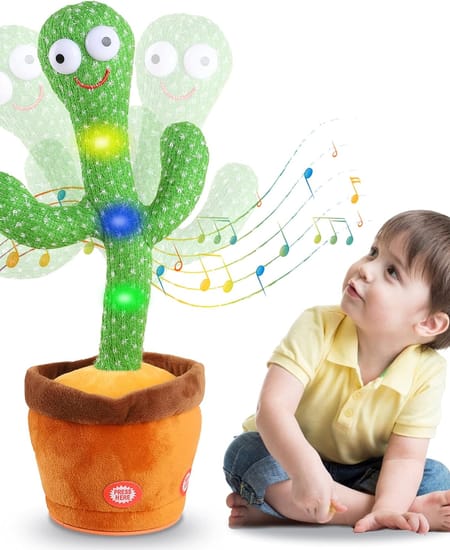Babies and young children can often be scared of unexpected things, from loud noises to unfamiliar faces. However, one particularly surprising fear that has been observed in babies is the fear of cactus toys. These small, plush toys shaped like cacti have become popular among parents as cute and educational toys for their children.
So why are babies afraid of them? In this article, we will explore the possible reasons behind this curious phenomenon and discuss how parents can help their children overcome this fear.
What is a cactus toy?

A cactus toy is a soft, plush toy designed to resemble a cactus plant. These toys come in various sizes and designs, from small keychain versions to larger ones that can be used as pillows or decorative items for children's rooms. They are often brightly colored and have cute faces or other features such as flowers or fruits attached to them.
Cactus toys are not just adorable playthings; they also serve an educational purpose. Many of these toys have different textures and shapes, which can help children learn about plants and nature at an early age. Some even come with information cards or books about cacti, making them a fun and interactive way to introduce children to the wonders of nature.
While cactus toys may seem harmless to adults, they can elicit a strong fear response in babies and young children. So what could be causing this fear?
Possible Reasons Why Babies Are Scared Of The Cactus Toy

There is no definitive answer as to why babies may be scared of cactus toys. Every child is different, and their fears can stem from various sources. However, some possible reasons for this fear could include:
Appearance
One possible reason for a baby's fear of cactus toys is their unusual appearance. Unlike the familiar shapes of typical plush toys, cactus toys often have an unconventional design with protruding arms and a somewhat spiky shape.
This might be visually perplexing or intimidating to a baby who is still developing their understanding of the world around them. The bright, vibrant colors of these toys, while appealing to older children and adults, may be overwhelming or startling to a young child’s sensitive eyes.
Additionally, the presence of cartoonish faces with exaggerated expressions can sometimes appear strange or unsettling to a baby, leading to an instinctive fear response. Overall, the combination of these visual elements can make cactus toys look quite different from what babies are used to, triggering their sense of caution or fear.
Prickly texture
Another possible reason for a baby's fear of cactus toys could be the prickly texture of the toy. When touched, cactus toys can feel rough and spiky due to their plush fabric mimicking the appearance of real cacti. This may cause discomfort or even pain if a baby accidentally pokes themselves with the toy's "spikes," leading to a negative association with it.
Babies are also naturally curious and tend to explore objects by touching them, so the unfamiliar sensation of a prickly texture can startle or frighten them, causing them to recoil or cry. Moreover, young children are sensitive to different textures and may find the sensation of a cactus toy's "spikes" unpleasant, leading to an aversion towards it.
Past experiences
Lastly, some babies may exhibit fear towards cactus toys due to past negative experiences with them. For example, if a baby accidentally hurt themselves with the toy's spiky texture or had a scary encounter with a real cactus plant, they may associate all things related to cacti with danger and fear.
Moreover, if a baby has witnessed someone else being afraid or reacting negatively toward a cactus toy, they may imitate that behavior and develop their own fear towards it. This could also be influenced by media portrayals of cacti as prickly and dangerous plants.
Helping Babies Overcome Their Fear Of Cactus Toys

If your baby is afraid of cactus toys, there are a few things you can do to help them overcome their fear:
- Introduce the toy gradually: Start by showing your baby the toy from a distance and gradually move closer. This will help them get used to the appearance and texture of the toy without feeling overwhelmed.
- Explain the toy's purpose: Talk to your child about what a cactus is and why people have toys shaped like it. This can help them understand that the toy is not something to be afraid of.
- Make it a positive experience: Play with the cactus toy together with your child, making it a fun and enjoyable activity. You can also use this opportunity to teach them about different shapes, colors, or textures.
- Validate their fears: It's essential to acknowledge and validate your child's fear, even if it seems irrational to you. By doing so, you can help them feel understood and supported, which can go a long way in helping them overcome their fear.
It's natural for babies to develop fears of certain things as they grow and explore the world around them. As parents, we can support our children through these fears by understanding their possible reasons and taking steps to help them feel safe and secure.
Other Types of Toys That Babies Love

Apart from cactus toys, babies love and enjoy playing with many other types of toys. Some popular choices include:
Soft and squishy toys
If your child is still scared of cactus toys, you can try introducing them to other soft and squishy plush toys. These types of toys are usually smaller in size and have a smoother texture, making them less intimidating for babies.
For younger infants, 0-6 months toys are a good choice, as they are still developing their motor skills and prefer toys that are easy to grasp and hold. Also, soft toys with crinkly or squeaky sounds can be highly stimulating and entertaining for them.
Additionally, Soft and squishy toys with different textures or parts to explore can aid in sensory development and keep babies engaged in playtime. As babies grow and develop, they can also use these toys for pretend play, making them versatile and long-lasting.
Interactive toys
Interactive toys are another great option for babies who enjoy playing with cactus toys. These types of toys engage children through lights, sounds, or movement, promoting their cognitive and motor skills development.
For older infants aged 6-12 months, interactive toys such as shape sorters, pop-up animals, or activity tables can provide endless hours of fun and learning. These toys also encourage hand-eye coordination and problem-solving skills in babies.
Furthermore, as children continue to grow, they can use these toys for imaginative play and practice social skills such as turn-taking and sharing with others. Interactive toys are a great way to keep babies entertained while promoting their development.
Montessori toys
Montessori toys are designed based on the principles of the Montessori educational method, which focuses on hands-on learning through self-directed activity. These types of toys are often made from natural materials and have a simple, open-ended design that allows children to explore and create at their own pace.
For toddlers aged 1-3 years, Montessori toys such as wooden stacking blocks, puzzles, or threading beads can help them practice fine motor skills and problem-solving abilities. They also promote creativity and imagination in young children.
Moreover, Montessori toys are eco-friendly and durable, making them a great choice for environmentally conscious parents. These types of toys encourage independent play and self-discovery in babies while helping them develop essential skills for future learning.
Musical toys
Babies naturally love music and making noise, which is why musical toys are a popular choice among parents. These types of toys come in various forms, such as rattles, drums, or xylophones, and can engage babies through different sounds and melodies.
For toddlers aged 1-3 years, musical toys offer an opportunity for creative expression and imaginative play. They also promote hand-eye coordination and help children develop a sense of rhythm and beat.
Moreover, musical toys can be used for group play, making them great for social development in young children. Some musical toys also come with educational features such as numbers or colors, adding an element of learning to playtime.
Stacking and nesting toys
Stacking and nesting toys are simple yet effective toys that promote problem-solving skills, hand-eye coordination, and fine motor skills in babies. These toys come in various forms, such as stacking cups, nesting blocks, or wooden puzzles.
For toddlers aged 4 months and above, stacking and nesting toys are a great way to introduce basic concepts such as size, shape, and colors. As children grow, they can also use these toys for imaginative play and building structures.
Moreover, stacking and nesting toys encourage problem-solving skills as children figure out how to fit the pieces together or stack them in the correct sequence. These types of toys also promote hand-eye coordination and fine motor skills as children manipulate the pieces.
How to choose the right toy for your baby
When it comes to choosing the right toys for your baby, there are a few factors you should consider. Firstly, make sure the toy is age-appropriate and safe for your child. Check the recommended age range and look for any potential choking hazards or sharp edges.
Secondly, consider your child's interests and developmental stage. Babies have different preferences when it comes to playing, so observe what kind of toys they gravitate towards and choose accordingly. For example, if your child enjoys exploring textures, opt for soft and squishy toys with different surfaces.
Another important factor to consider is the toy's durability and longevity. Babies grow and develop quickly, so it's essential to choose toys that can adapt to their changing abilities and interests. Look for versatile toys that can be used for different purposes and will last through different stages of development.
Lastly, don't forget about your own values and beliefs when choosing a toy for your baby. If you value eco-friendly or educational toys, make sure to research and find options that align with your preferences.
FAQs
Why do some babies react negatively to the dancing cactus toy?
Some babies might find the dancing cactus toy a bit overwhelming due to its sudden movements and loud singing. While the toy is designed to dance and sing in a way that's intended to be hilarious and entertaining, the unexpected motion and noise can be startling for younger children who are not accustomed to it.
Can the movement of the moving cactus toy sometimes go wrong and scare babies?
Yes, if the moving cactus toy behaves erratically or too briskly, it might scare babies. Occasionally, mechanical toys like these can function unpredictably, and their fast or unusual movements could be frightening for infants who are sensitive to sudden changes in their environment.
What should you do if a baby is scared by the dancing and singing of the cactus toy?
If a baby is scared by the dancing and singing of the cactus toy, it's best to remove the toy from the baby's immediate environment to help calm them. You can reintroduce the toy later by first showing how it works from a distance to familiarize the baby with its functions in a more controlled manner, ensuring the volume is not too high and the dance movements are not too sharp.
How can parents ensure their baby enjoys the dancing cactus toy without fear?
Parents can ensure their baby enjoys the dancing cactus toy without fear by gradually introducing the toy. Start by letting the baby observe the toy's actions from a safe distance. Gradually decrease the distance as the baby becomes more accustomed to how the toy moves and sings. Additionally, interacting with the toy alongside the baby can help demonstrate that it's safe and fun, turning a potentially scary experience into a hilarious and enjoyable one.
Conclusion
In conclusion, choosing the right kind of toy for your baby is crucial for their development and enjoyment. Whether it's cactus toys, interactive toys, Montessori toys, musical toys, or stacking and nesting toys, each type offers unique benefits that can aid in your child's growth and learning.
By considering factors such as safety, age-appropriateness, durability, and personal values, you can find the perfect toy for your little one to enjoy. Remember to have fun and play along with your child – after all, playtime is an essential part of childhood!
So go ahead and explore the world of toys to find the perfect fit for your baby's playtime. Let their imagination soar and watch as they learn and grow through play! Happy toy hunting!
Subscribe to our email newsletter and unlock access to members-only content and exclusive updates.

Comments